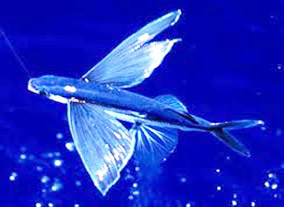Flying Fish
Common Name: Flying Fish
Scientific Name: Cypselurus melanurus
Description

Exocoetidae is called as flying fish are a marine fish family comprising about 64 species grouped in seven to nine genera. Their most striking feature is their pectoral fins, which are abnormally large, and enable the fish to hide and escape from predators by leaping out of the water, taking short glided flights through air just above the water's surface. Their glides are typically 40 m to 50 m, but they can use updrafts at the leading edge of waves to cover distances of at least 400 m (1,300 ft).
Diet
Flying fish feed mainly on plankton. Predators include dolphins, tuna, marlin, squids, porpoises and birds.
Behaviour
In order to glide out of the water, a flying fish swishes its tail to up to 50-70 times per second, which "vibrates" to produce sufficient speed to burst through the surface. It then spreads its pectoral fins and tilts them slightly upwards to raise itself to glide through the air. This permits it to cruise above the ocean's surface where it can at travel at speeds of more than 70 km/h. At best, the longest known glide made by a flying fish genus Cypselurus is reported sailing 250 m or more above water.

Location or Region Found
Flying fish are found in all of the major oceans, particularly in the warm tropical and subtropical waters of the Pacific, Atlantic and Indian oceans.
 Deep Sea Crabs
Deep Sea Crabs